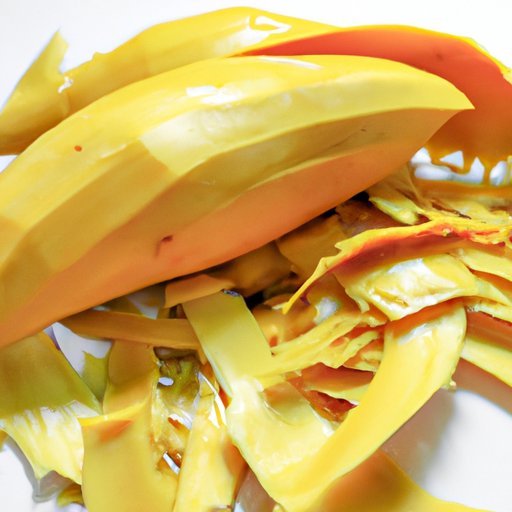Introduction
Mangos are one of the most popular fruits in the world. They are a nutritional powerhouse, packed with vitamins, minerals, and antioxidants that can help boost your health. But did you know that you can also eat the peel? While it may not be as tasty as the flesh, the peel of a mango has some surprising health benefits and can be used in some interesting recipes. In this article, we’ll explore the nutritional benefits of eating mango peel, how to safely prepare and cook it, and creative ways to incorporate it into your diet.
The Nutritional Benefits of Eating Mango Peel
Mango peel is an excellent source of essential vitamins and minerals, including Vitamin C, potassium, magnesium, and iron. A 100-gram serving of mango peel contains about 20% of your daily recommended value of Vitamin C, which helps to boost your immune system and protect against free radical damage. The peel also contains dietary fiber, which helps to support digestive health and can promote satiety after meals. Additionally, mango peel contains several important phytochemicals, such as carotenoids and polyphenols, which have antioxidant and anti-inflammatory properties.
How to Safely Prepare and Cook Mango Peel
Before consuming mango peel, it’s important to make sure it is properly cleaned and cooked. To prepare the peel, start by washing it under cold running water. This will help to remove any dirt or debris that may be present. Next, use a vegetable brush to scrub off any remaining residue. Once the peel is clean, you can either eat it raw or cook it. To cook the peel, simply place it in a pot of boiling water and let it simmer for 10 minutes. This will help to soften the peel and make it easier to digest.
Is it Safe to Eat Mango Peel?
Despite the many nutritional benefits of eating mango peel, there are some safety considerations to keep in mind. One of the biggest concerns is the potential for contamination. The peel of a mango is porous, which means it can absorb pesticides and other chemicals that may be present on the fruit. Additionally, mangoes are often treated with wax to keep them fresh, and this wax can contain potentially harmful chemicals. For these reasons, it’s important to always buy organic mangoes if you plan on eating the peel.
In addition to potential contamination risks, it’s important to be aware of the potential choking hazard posed by mango peel. The peel is tough and fibrous, which means it can be difficult to chew and swallow. It’s best to avoid giving mango peel to young children, as they may not be able to properly chew and swallow it. For older children and adults, it’s best to slice the peel into thin strips before consuming.

Exploring the Health Benefits of Eating Mango Peel
In addition to its nutritional benefits, mango peel also has some impressive health benefits. Studies have shown that the peel contains high levels of antioxidants, which can help to reduce oxidative stress in the body and protect against disease. Additionally, mango peel contains powerful anti-inflammatory compounds that can help to reduce inflammation in the body. These anti-inflammatory compounds may also help to reduce the risk of chronic diseases, such as heart disease and diabetes.

Debunking the Myths Around Eating Mango Peel
Despite the many potential benefits of eating mango peel, there are still some misconceptions about it. One of the most common myths is that eating mango peel can cause stomach pain or other digestive issues. While it is true that the peel is tough and fibrous, studies have shown that it is safe to consume and does not pose any significant health risks. In fact, the peel may even help to improve digestion, as it is a good source of dietary fiber.
Another myth is that eating mango peel can cause allergic reactions. While this is possible, it is very rare. Most people who are allergic to mangoes are only allergic to the flesh, not the peel. If you do experience any adverse reactions after eating mango peel, it’s best to discontinue consumption and speak to your doctor.
Using Mango Peel as an Ingredient in Recipes
Mango peel can be used in a variety of recipes, from salads to smoothies to soups. Before adding the peel to a recipe, it’s important to make sure it is properly prepared and cooked. To make the peel more palatable, try slicing it into thin strips and marinating it in a mixture of lemon juice and olive oil. This will help to soften the peel and give it a milder flavor. You can also add the peel to smoothies or sauces for an extra boost of flavor and nutrition.

Creative Ways to Incorporate Mango Peel into Your Diet
Eating mango peel doesn’t have to be boring! There are plenty of creative ways to incorporate it into your diet. Try adding it to salads for a crunchy texture, blending it into smoothies for an extra dose of nutrition, or using it as a topping for soups or sauces. You can even use the peel to make mango chips – just slice the peel into thin strips, season with spices, and bake in the oven until crisp.
Conclusion
Mango peel is a nutritional powerhouse, packed with essential vitamins and minerals that can help boost your health. It also has some impressive health benefits, including antioxidant and anti-inflammatory properties. When eaten in moderation and prepared and cooked properly, mango peel can be a delicious and nutritious addition to your diet. So go ahead and give it a try – you may be surprised by what you find!
In summary, eating mango peel has many potential health benefits and is generally safe when prepared and cooked properly. Be sure to buy organic mangoes to minimize the risk of contamination, and keep in mind the potential choking hazard for young children. With a little creativity, you can easily incorporate mango peel into your diet and reap the rewards of its nutritional goodness.
(Note: Is this article not meeting your expectations? Do you have knowledge or insights to share? Unlock new opportunities and expand your reach by joining our authors team. Click Registration to join us and share your expertise with our readers.)
